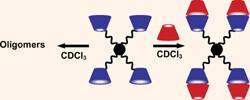A new structure has been developed that promises to serve as the core for a novel self-assembling dendrimer.
A new structure promises to serve as the core for a novel self-assembling dendrimer. Volker B?hmer and co-workers at the University of Mainz, Germany, have investigated the self-assembly of dendrimers, highly branched spherical polymers which radiate out from a central core.
Self-assembling materials make themselves from component building blocks. This process allows complex structures to be built efficiently from simple starting materials. The key to self-assembling materials is in the design of the building blocks; each unit must connect to the next in a single, pre-determined way, so that only the desired product is formed.

The design of the core unit is crucial to the self-assembly of the dendrimer. B?hmer chose to make his core from calixarenes, cone-shaped molecules to which functional groups can be attached at both the wide and the narrow rim. Calixarenes bearing four urea groups on the wide rim are know to pair up, or dimerise, in solution. B?hmer believes this interaction could form the basis for self-assembling dendrimers.
To test the self-assembly principle, he made a dendrimer core by using long, flexible arms to link four calixarenes to a central point, each calixarene bearing four urea groups. The calixarenes in the core then spontaneously paired with free calixarenes functionalised with urea groups.
The final step towards self-assembling dendrimers will be to develop branched calixarene building blocks to pair with the core, rather than the free calixarenes tested to date. This development will ultimately allow the dendrimer to continue to grow outwards.
James R Mitchell Crow
References
Y Rudzevich, K Fischer, M Schmidt and V Böhmer, Org. Biomol. Chem., 2005, 3, 3916 (DOI: 10.1039/<MAN>b509948j</MAN>)






No comments yet